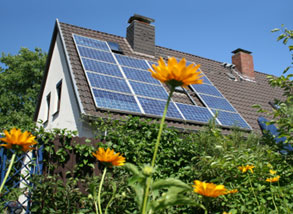Having a solar PV system at your house raises its market value and makes it quicker to sell, according to The Appraisal Institute, the trade association of real estate appraisers.
People are increasingly looking to buy homes that have solar PV systems, they find. Although the study was done in the metro-Denver area, it could well apply elsewhere.
A report released last year by Lawrence Berkeley National Lab showed that having solar PV boosted the sales price in California. The premium was about the same as the cost of the solar system. Another study found that green-certified homes sell for 9% more in California. Also, mortgage defaults are much lower among people that live in Energy Star-certified homes.

The Appraisal Institute has been doing a lot of training on valuing green features in homes – since 2008, 5100 appraisers have attended 380 programs on the topic.
This year, they added a course on valuing solar systems to its "Valuation of Sustainable Buildings Professional Development Program," which teaches appraisers how to value high-performance residential and commercial buildings.
A book on the subject will be published early next year, "Residential Green Valuation Tools," by Sandra Adomatis.
On the commercial side, numerous studies show that tenants increasingly want building management systems, such as zoned HVAC, maintenance alert systems, and green buildings in general. Buildings rent faster at higher rents and are worth more when they are sold. LEED-certified and Energy Star buildings sell for about a 13% premium, report Jones and LaSalle.
Building management firm, Jones Lang LaSalle finds this Marketing Advantage is one of several major trends in their report, The Changing Face of Smart Buildings: The Op-Ex Advantage.
Rapid return on investment (ROI): Investments in smart building technology have typical pay-back periods of 1-2 years through operational efficiencies and energy savings. As adoption of these technologies has increased, costs have dropped substantially. It costs just $50, for example, for intelligent lighting components that cost $120 four years ago.
Annual energy savings of 8-15% occur immediately after deployment. Every dollar invested in energy efficiency produces $3 of operational savings.
Operating-expense advantage: There’s a lot of bank for the buck for smart building technologies – little up front cost, but significant reduced operational expenditures. Using automated systems, problems are detected before equipment fails and require capital expenditures.
Improved Corporate Social Responsibility profile: Besides the reputational advantages of greening buildings, smart building systems can measure and report on greenhouse gas emissions. It can feed the information directly into databases for sustainability reporting or to the various cities that now require annual reports. It can even be rolled together across a portfolio of buildings.
Here is their report:
